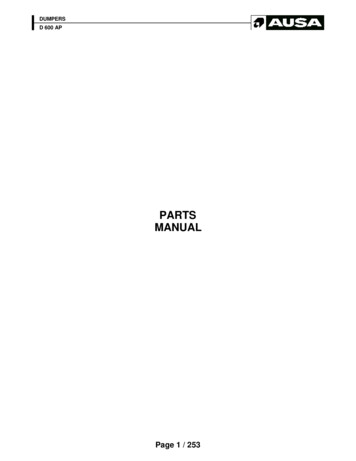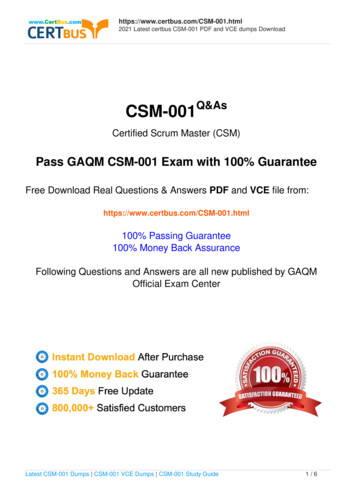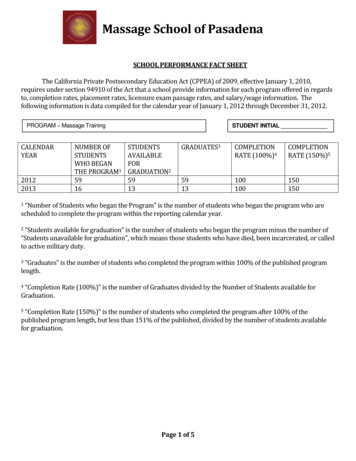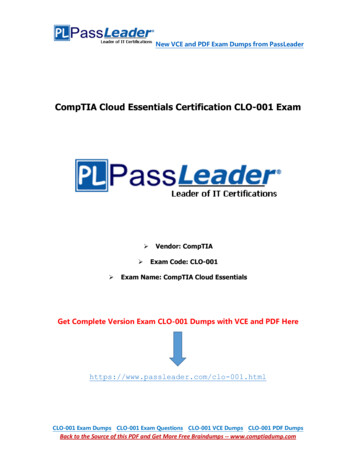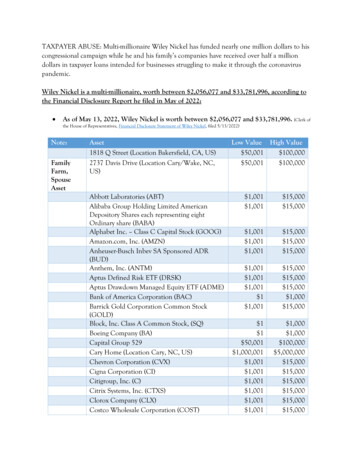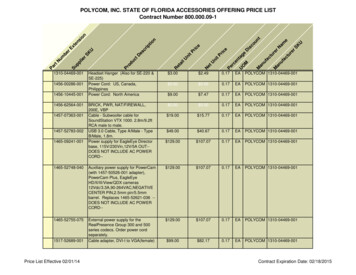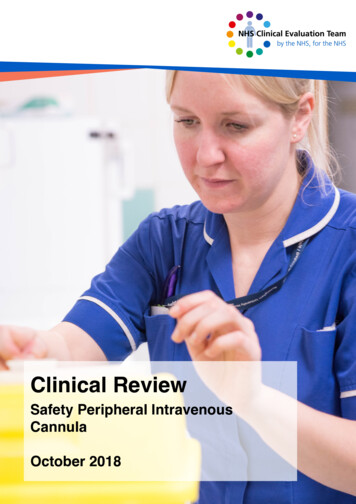
Transcription
Clinical ReviewSafety Peripheral IntravenousCannulaOctober 2018
Contents12Introduction.4Clinical Context.52.1Clinical Definition and Scope .52.2Clinical Practice .52.3Clinical Impact .62.3.1Impact on the patient .62.3.2Impact on the clinician .72.4Other Clinical Considerations .72.5Product Technical Design.83 Pathway Methods .93.1Intelligence Gathering .93.1.1Literature search .93.1.2National procurement provider specification .93.1.3National and international safety and quality standards .113.1.4Product suppliers and manufacturers .113.1.5Quality of evidence.123.2Best Practice Guidelines.133.3Patient Perspectives .134 NHS Clinical Engagement .134.1Clinical Conversations .144.2Clinical Criteria .144.2.1Criteria explanation- Exclusion .174.3Product Evaluation .175 Product Assessment Results .206 Using the Product Assessment Results Matrix .207 Further Considerations and Recommendations .217.1Future recommendations.217.1.1Packaging .217.1.2Opening .217.1.3Clinical Use .217.1.4Disposal .227.1.5Further Considerations .227.2Barcodes .228 Disclaimer .239 Acknowledgements .2310 Authors and NHS Clinical Evaluation Team Information .2411 References .252
Guidance for useThis clinical evaluation report is aimed primarily at the NHS and all those working tosupport patient care.Please note that the product assessment results should only be read and used inconjunction with the full text of this clinical review.3
1 IntroductionThe NHS Clinical Evaluation Team was established in April 2016. The team’s remit isto add independent clinical review to ‘everyday healthcare consumables’ used by theNHS.Everyday healthcare consumables are products found in the majority of wards, clinics,health centres, treatment rooms and community nurses’ bags across the NHS. Thepurpose of this report is two-fold: firstly, to provide a clinical assessment of the usabilityand requirements from the NHS Safety Peripheral Intravenous Cannula or Catheter(SPIVC) that are available to the NHS from the national procurement provider andsecondly, to provide a clinical statement of desired functions and properties that theclinicians in the NHS require of SPIVC for use in future procurement activities.It is clear from the evidence that the SPIVC featured in this report are everydayhealthcare consumables that are found in pre-hospital care, some community settings,outpatient and most acute ward settings, hence they are items included in any stocklist when setting up a new clinical service. On that basis, the project was approved bythe Clinical Reference Board (CRB) culminating in the production of this report for theirapproval in October 2018.Based on NHS Supply Chain data, over 300 NHS Trusts use SPIVC, with over 25Million SPIVC sold annually resulting in a total spend approaching 25 Million in 20162017 with 0.32% increase in 2017-2018. There are over 200 different SPIVC productcodes supplied via 8 different suppliers. This report covers the range of productsavailable as of August 2017.Intelligence about SPIVC was initially gathered from a variety of sources to providebackground information on the current evidence available to support the way productsare designed and clinically evaluated.Subsequently clinical engagement sessions were held with frontline NHS clinicianswith the aim of identifying important clinical criteria for SPIVC. This information wasused to develop the clinical criterion against which brands available from the nationalprocurement provider were reviewed.Findings from these clinical reviews have been collated into a product assessmentreport to allow users to identify products and see how they performed against theagreed clinical criteria.A more detailed description of the team and our pathway approach can be found inthe NHS Clinical Evaluation Team operating manual which can be found on ourwebsite at: www.supplychain.nhs.uk/CET4
2 Clinical Context2.1 Clinical Definition and ScopeModern IV catheters/cannulae was revolutionised in the 1950’s at the Mayo Clinic inthe United States (Rivera, 2005). Advances in technology and incorporation of bestevidence practices have led us into “smarter” integrated systems. Safety PeripheralIntravenous Cannula or Catheter (SPIVC) is a vascular access medical device whichis directly threaded into a vessel after venepuncture with a needle, known as a stylet(“catheter over the needle” configuration) for the purpose of administering intravenous(IV) therapy such as IV fluids or medications, directly into a blood vessel or obtain ablood sample at the time of insertion.This report is mainly focused on SPIVC used for the purpose of administration ofcompatible and/or appropriate IV therapy. This evaluation was based upon onecannula gauge, due to the variety of gauges and products available and limitedresources. It does not therefore include non- safety products, i.e. no needle safetymechanism or shield, or any other cannula/catheter not intended for venous access.Within the NHS Supply Chain (NHS SC) framework, there are numerous differentneedle gauges, sizes and lengths of SPIVC. There is a degree of ambiguity with thedescriptions of a number of products; therefore this report presents subcategories,using groups and materials.For the purpose of this report, the SPIVC is subcategorised into four groups: Ported CannulaNon-Ported Cannula (Straight or Non-winged)Non-Ported Cannula (Winged)Integrated CannulaWithin these four groups the SPIVC are used in different clinical settings.Intended Clinical UseSPIVC is designed as a vascular access device facilitating the administration ofappropriate short-term (3-5 days) IV therapy infusions, such as IV antibiotics,chemotherapy, and parenteral nutrition, as well as for bolus intravenous injections orshort infusions in the outpatient/day unit setting and blood sampling (RCN Standardsfor infusion therapy, 2016).Professional guidance by consulting vascular access and IV therapy experts and anacademic literature review have been undertaken to substantiate the development ofclinical criteria to support the evaluation of these products.2.2 Clinical PracticeSPIVCs has been clearly demonstrated in the literature as the most commonly useddevice for obtaining vascular access in various clinical settings. Almost a billion5
SPIVCs are inserted around the world each year and noted that up to 60% of inpatientsin UK hospitals will have at least one peripheral IV access device in use (Alexandrouet al 2015). It is widely documented, that because it is an invasive and frequently usedprocedure, it is associated with a range of negative outcomes, local and systemiccomplications. The most common of which is mechanical phlebitis due to trauma tothe vessel, which could result to inflammation and subsequently thrombosis andsepsis. Therefore whilst the risk of complications for the individual patient such asSPIVC- related bloodstream infection (BSI) is low, the absolute number of reportedcomplications is high. This emphasises the need not just for accurate patientassessments but also for careful product selection.2.3 Clinical Impact2.3.1 Impact on the patientIt is widely noted in the UK, that one in three patients admitted into hospital has atleast one peripheral IV cannula. Evidence shows that, insertion of SPIVC is the mostcommon invasive procedure, effective and quickest venous access device of choicefor administration of IV therapy (Barton 2018; Carr et al, 2016).An ideal SPIVC should facilitate delivery therapy into peripheral veins withoutsubsequent avoidable undesirable outcomes. SPIVCs come with widely documentedassociated complications: Bacterial, Chemical and Mechanical Phlebitis, bacteraemia,extravasation/infiltration, haematoma and sepsis. In today’s era of advancedtechnology cannula/catheters are designed to prevent many of these complications.These complications may be avoided if health care professionals adhere to guidelines,for example, aseptic non-touch technique (ANTT), decontamination of site of insertionbefore cannulation careful monitoring and selecting the right device. Relevant to thisreport, the theory behind device selection is well documented. The epic 3 guidelines(2014) and the Vessel Health and Preservation (VHP) framework, evidence how toselect the right IV device at the correct time in relation to IV Therapy duration. Use ofthe VHP framework can ensure that the right vein and vascular access device areselected when needed (Hallam, et al 2016; Moureau, et al 2012; Shaw, 2017).However, SPIVC selection can still be quite daunting due to the variations availablefor purchase via the NHS SC framework. Although SPIVC designs and individualfeatures vary these variations may or may not have been influenced by clinicians overthe years.Another highlighted issue in our conversations with clinicians is pain. It is not justassociated with skill and speed of the inserter, but more importantly the sharpnessand geometry of the needle tip, the gauge of the catheter, and the material of theplastic in the catheter.In this report, a needle penetration test (See Chart 1) was conducted to measure theforce required for the needle and cannula to penetrate skin. The test involved piercingan acetate film (0.12 mm thickness) and the use of a tensometer to measure the forcerequired.6
In addition to this a “Stiction test” (otherwise known as stationary friction), wasperformed (See Chart 2). It is a test of the static friction that needs to be overcomedto enable relative motion of a stationary object in contact with another surface. Thetest is designed to assess the initial stiction that has been evident with some designsof cannula which can result in displacement of the cannula from the patient. Due tovariability in safety cannula designs, in which some of the highest forces recorded arenot on the initial withdrawal of needle and for the purpose of this report the initial 20mmwithdrawal distance was measured.Both tests were performed on 3 replicates and the mean force was calculated.It will be noted as well in this report, a subcategory by catheter material used to helppractitioners make an informed decision with their SPIVC choices.2.3.2 Impact on the clinicianFor a clinician, the ideal catheter should provide protection to the user against sharpsinjury with advanced engineering to ensure safety and ease of use. An SPIVC whichprotects the tip after use, preferably passively as an additional safety measure thatalso prevents the escape of blood thereby providing protection against mucocutaneous exposure (Council of the European Union, 2010; RCN Sharps safety,2011;).A rapid reliable blood flashback after penetrating the vein will prompt the clinician tostop advancing and thereby making traversing the opposite wall of the vein(transfixation) less likely is advocated. Additionally visibility of the puncture site, withtransparent cannula/catheter components (e.g. transparent wings) will enable theclinician to observe the site at all times. Furthermore” closed” system with needlelessaccess to ports also prevents bacterial entry more efficiently than conventional ones(Barton, 2018).Thus for the majority of clinicians the optimal SPIVC is one with a flat profile whichallows a dressing to cover it smoothly without wrinkling, making it less likely to catchon objects in the environment and accidently dislodge.2.4 Other Clinical ConsiderationsThe materials used for the cannula/catheter change their stiffness after a period oftime at body temperature (i.e. in the vessel) and are less likely to kink or bend thereforereducing mechanical phlebitis. However, this sits outside this evaluation. Furthermore,there is little evidence to show that catheter material is important in the aetiology ofcatheter related complications.SPIVC dwell-time remains an area of debate in the literature. More than a decade ago,the Infusion Nurses Society (INS) recommended IV site rotation every 72 hours or lessand in 2011 the recommendations changed to being based upon clinical indication.Similarly, the epic 3 Guidelines (IVAD 28) recommends, peripheral vascular catheterinsertion site should be re-sited when clinically indicated and not routinely, unless7
device-specific recommendations from the manufacturer indicate otherwise.Conversely, the Centres for Disease Control and Prevention (CDC, 2011) guidelinescontinue to make no recommendation for IV site rotation. Hence manufacturer’srecommendations should be followed and clinicians should adhere to local hospital orclinical setting’ policy.2.5 Product Technical DesignA SPIVC is composed of a hollow, metal needle that is bevelled at one end andsheathed in a plastic catheter tube. It is usually less than or equal to 7.5 cm in length(Rivera, 2005). The ranges available in the NHS SC catalogue are indicated in thematrices.It has a safety engineered needle safety device that essentially passively or activelyactivated as the needle is withdrawn when the vessel is accessed andcannula/catheter component is in situ. As stated in the beginning, for the purpose ofthis report, SPIVCs evaluated are subcategorized into the following designs: Ported Cannulae are with an additional port or opening built onto the top ofthe cannula hub with a closure from tethered, irreplaceable cap. These arealso known as “open cannula” which has no blood control which means veinocclusion is required to reduce risk of blood leakage and spillage(Dougherty and Lister, 2015). Non-Ported Cannula (Straight or Non-winged) are without a port on theneither hub nor stabilisation platforms. Non-Ported Cannula (Winged) are with stabilisation platforms (wings), whichaid in securement of the device, reducing the risk of” pistoning” (micromovement) in the vein, thereby reducing risk irritation of vessel wall(phlebitis) (Dougherty and Lister, 2015). Integrated Closed Cannula are non-ported device with a pre-attachedextension set and integral needle-free connectors and a stabilisationplatform which reduces” pistoning” within the vessel ("Bausone-Gasda et al2010). These provided closed integrated system with a passive safetymechanism.8
3 Pathway MethodsThe evaluation followed the process given in the CET operating manual, and asapproved by the overseeing Clinical Reference Board.3.1 Intelligence GatheringIn preparing the criteria for this evaluation, the relevant clinical evidence, knownguidance and nationally recognised publications, as further described in this Section3, have been incorporated. Suppliers listed within the national framework were invitedto provide clinically relevant evidence. The majority of suppliers provided informationranging from information brochures to technical data sheets.3.1.1 Literature searchA literature search was undertaken to establish what current academic knowledgeexists on the products for evaluation. It should be noted that the team have notconducted a systematic review of the literature. However, the team have interrogatedthe information to look for common themes which supported the development of theclinical criteria.Initially, an evidence search was performed across the NICE service:There were no returns from this search which stated the clinical requirements in thedevelopment, design and supply of the products.The search terms used (see below) generated many returns, however, there was littlenew information generated of relevance.Search criteriaDatabases searched Vascular Access Peripheral Venous AccessNICE website Evidence searchhttps://www.evidence.nhs.uk/ Safety Peripheral IV Catheter Medline, NICE,https://www.supplychain.nhs.uk/ Cochrane, NIHR and Grey Literature. NICE website journals and vidence-services/journals-anddatabases Further search of specialist resourcesincluding: NICE, SIGN,Date RangeSince 2005Figure 1 – Literature and other sources searches – Safety Peripheral Intravenous Cannula" under the table9
3.1.2 National procurement provider specificationAs the national procurement provider, the NHS Supply Chain manages a frameworkof suppliers listed in the national catalogue. However the framework covers a widerselection of products than just safety peripheral intravenous cannulae. The nationalprovider specification (NHS Supply Chain) has been reviewed to understand whatsuppliers of these devices have previously been asked. However this specification(NHS Supply Chain) gives insufficient detail relating to the clinical criteria relevant forsafety peripheral intravenous cannulae, it has been considered in the process fordeveloping such criteria.Standard /CertificationMedical Devices Directive 93/42/EECAll products classified as a Medical Device must have their CE marking clearlyevident on the product and/or packagingBS EN ISO 10993-1: October 2009Biological evaluation of medical devices. Evaluation and testing within a riskmanagement process All products and packaging should be latex free where possible. Anyproducts or packaging containing latex must be clearly labelled as such toinform the user Any product containing phthalates must be indicated on the packaging inaccordance with Directive 2007/47/EC (amending Directives 90/385/EECand 93/42/EEC). In accordance with the Control of Substances Hazardous to Health(COSHH) Regulations 2002 (as amended) safety data sheets for allproducts that fall under this Regulation must be provided to NHS SupplyChainIn accordance with the Control of Substances Hazardous to Health Regulations 2002(as amended) safety data sheets for all product lines that fall under these Regulationsmust be provided to NHS Supply Chain. During the term of the Framework Agreement NHS Supply Chain must bemade aware of any awarded product line that is classed by the MHRA as aMedicinal Product. All product line(s) must be delivered to NHS Supply Chain, or in the case ofgoods delivered via the Direct Route of Supply to the end customer, with aminimum 2 years shelf life. Any shelf life limits and/or specific storage conditions (required afteropening or reconstituting) for the product must be clearly stated on theproduct packaging.10
NHS Supply Chain (or any third party appointed at the absolute discretion ofNHS Supply Chain) reserves the right to test product lines throughout theterm of the Framework Agreement to ensure it complies with theSpecification and meets customer requirements provided these have beenmade known to the supplier. If any product lines are found not to complywith these requirements then the NHS Supply Chain reserves the right to: Charge for the cost of testing and any required retesting. Suspend the sale of the affected product line(s). Terminate the Framework Agreement in accordance with the provisions setout therein.It should be noted that although the NHS Supply Chain specification providesinsufficient detail relating to the clinical criteria relevant for safety peripheralintravenous cannula; these specifications have been considered in the developmentprocess of the clinical criteria3.1.3 National and international safety and quality standardsAccount has also been taken of appropriate standards, international and other,pertaining to the devices (e.g. from the International Organisation for Standardisation(ISO), European Standards (EN) and/or British Standards Institution (BSI). A reviewof the Medicines & Healthcare products Regulatory Agency (MHRA) alerts has alsobeen performed, with product alerts relating to this product category identified howeverthe Medical Device Directive 93/42/EEC as amended is currently in transition to thenew Medical Device Regulation MDR 2017/745 whereby: All products classified as a Medical Device must have their CE markingclearly evident on the product and/or packaging and meet the requirementsset out within the standard(s) related to labelling.3.1.4 Product suppliers and manufacturersAll suppliers listed within the national framework were invited to submit relevantevidence, product information and testing data to help support the review. This wasguided by provision of a standardised data set to promote return of relevant andconsistent information such as: Product description and medical device classification. Copies of certificates of conformity to relevant EN and ISO standards ISO 10555-55:2013 ISO 9626 EN ISO 13485:2016. Quality management systems for medicaldevices BS EN ISO 14001. Environmental management systems Copy of declaration of conformity to MDD 93/42EEC or MDR 2017/745. Technical data sheets.11
Details of adverse incident reports (if any have occurred) Copies of company protocols for product recalls and actions should thesebe necessary. Indications for use and precautions/contra-indications for use. Any potential allergens the product contains. Range available. Instructions for use. Shelf life of product Any existing clinical evidence or laboratory testing to support product qualityand effectiveness.3.1.5 Quality of evidenceHierarchy of evidenceLevels of evidence sometimes referred to as hierarchy of evidence were assigned tostudies based on the methodological quality of their design, validity, and applicabilityto patient care.HierarchyrankingDescriptionLevel 1A systematic review of all relevant randomised controlled trials(RCT) or evidence-based clinical practice guidelines based onsystematic reviews of RCT evidenceLevel 2Evidence from at least one well designed RCTLevel 3Evidence from well-designed controlled trials; non-randomised,quasi experimentalLevel 4Well-designed case control & cohort studiesLevel 5Systematic reviews of descriptive and qualitative studiesLevel 6Evidence from a single, descriptive or qualitative studyLevel 7Evidence from the opinion of authorities and/or reports ofexpert committeesFigure 2 – Hierarchy ranking: Evidence based practice in nursing & healthcare: a guide to best practice” (B.M. Melnyk & E.Fineout-Overholt; 2005; p10)In clinical practice, it is encouraged to search and utilize the highest level of evidence(Level 1) for any clinical foreground questions. Clinicians come across with an everrapidly growing and changing body of evidence. As randomised control trials (RCTs)are designed without biased and with minimal risk of systematic errors, it is recognisedas the gold standard level of research trial (Tidy, 2014). However, with the fast movingadvancements with available products in IV therapy and as IV practice moves forward,vascular access experts’ recommendations to consider that the optimal research12
method may produce the most valid, practical outcome in practice. RCTs may be thegold standard, but they should not be the only research method seen as valid andreliable. Case studies may potentially be of better fit in current clinical IV practice. Inaddition, clinical judgement should not be underestimated as it is a critical andfundamental aspect of what we do as IV practitioners.3.2 Best Practice GuidelinesThere are a variety of peer reviewed publications and guidelines relevant to SPIVCsand their use. In the UK, the key recent publications and clinical practice guidelinesare from the British Journal of Nursing – IV Therapy supplements, RCN Standards forinfusion therapy, epic3: National Evidence-Based Guidelines for preventionhealthcare-associated infections in NHS hospitals in England. Internationally, theJournal for Association of Vascular Access (JAVA), Infusion Nurses Society (INS) Standards of practice for infusion nurses, Centres for Disease Control and Prevention(CDC) – Prevention of intravascular catheter-related infections. Furthermore a numberof local guidelines, produced by individual or aligned NHS providers, were consideredoffering guidance on vascular access device selection, including peripheral venousdevices.3.3 Patient PerspectivesPatients describe their experience with IV access devices as a “necessary evil”(Larsen et al 2017). Anecdotally, patients would express differing levels of anxiety andpain during peripheral cannulation procedure. Phlebitis is a common complication for20-80% of patients who receive PIVCs. It is not just painful for patients but also costlyin terms of healthcare resources.4 NHS Clinical EngagementIn order to develop a shared vision of what is required from SPIVCs, several methodsof engagement were used. These events were used to formulate thoughts, ideas andneeds from different clinicians familiar with these products. This facilitated identifyingtheir own expectation(s) of the product for their given patient group, intended patientoutcomes, and use in a variety of differing clinical environments.Mapping exercises were undertaken to determine the personnel that should beinvolved and/or consulted with regarding these products. This stage of the reportfocuses on clinical staffs that are:a) recognised as subject matter experts, and/orb) recognised regular users of the devices in their clinical practice.13
Various methods of engagement were undertaken to ensure these clinical opinionswere robust and validated by peers from around the country, options for engagementincluded: Regional and national face-to-face events with NHS clinical colleaguesFocussed visits to NHS clinicians regional and national face-to-face eventsWebsite subscriptionAttendance at NHS Business Services Authority eventsWeb-based surveys and e-engagement tools (e.g. email, WebEx, portalbased surveys)4.1 Clinical ConversationsTo build a broad caucus of attendees at our events letters were sent inviting Trusts tonominate clinical colleagues to attend a series of regional group events. These werehosted by NHS organisations throughout England to enable the widest possibleaccess for all invited whilst avoiding any pre-existing regional variance.Details of the discussion outcomes were recorded online from the open events andsurvey circulated to the specialist vascular access and IV therapy network via NationalInfusion and Vascular Access Society (NIVAS). Some respected members from WorldCongress for Vascular Access (WoCoVA) were also consulted for their expert opinion.Information received from these sources were transcribed and combined. This wasthen used together with the evidence gathered at the previous project stage to informa list of clinical criteria against which the product has been tested.4.2 Clinical CriteriaThe data received from all the NHS clinical conversation events, alongside the datacollected from individual experts, was assimilated into a series of clinical criteria.A clinical criterion is defined for the purposes of this report as a principle or standardby which products may be evaluated. It is a statement which describes the clinician’srequirements for the product.The proposed criteria were validated by workshop attendees and all other clinicalexperts engaged in the development process. In addition, other clinical experts whoare likely to add further useful insight were also included, leading to the finalisedclinical criteria listed below in Figures 3 and 4.14
4.2.1. Criteria explanation- InclusionTo enhance the readers understanding of this report, and to provide value to theresults, an explanation for the defined clinical criteria is captured.Clinical Criteria –Safety Peripheral IV CannulaRationale(Derived from Consultation with Clinicians)PACKAGIN
the Clinical Reference Board (CRB) culminating in the production of this report for their approval in October 2018. Based on NHS Supply Chain data, over 300 NHS Trusts use SPIVC, with over 25 Million SPIVC sold annually resulting in a total spend approaching 25 Million in 2016-2017 with 0.32% increase in 2017-2018.

